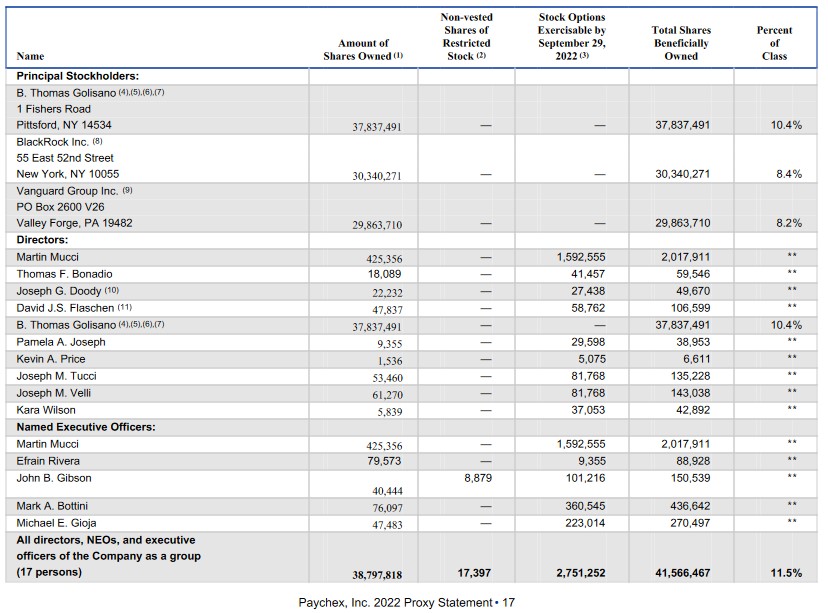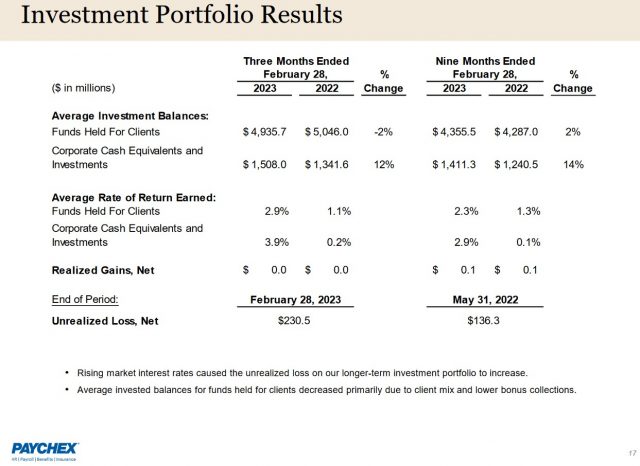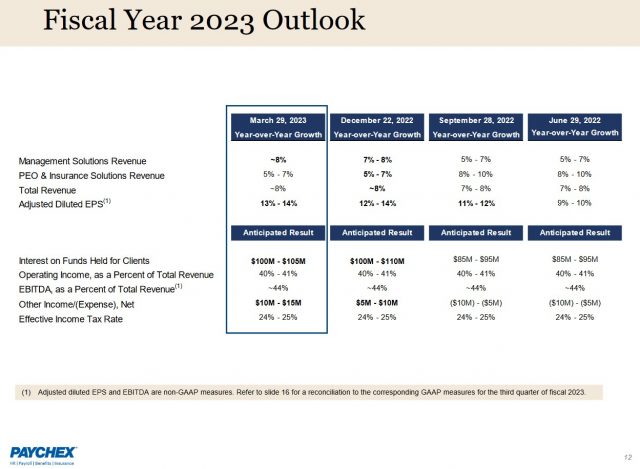Contents

In times of uncertainty, it helps if we use common sense when it comes to investing. Before I delve into why Paychex (PAYX) should appeal to risk-averse investors, I provide goeasy Ltd. (GSY.to) as an example of a company that should alarm investors; I touched upon this company in my December 27, 2020 post.
GSY provides non-prime leasing and lending services under the easyhome, easyfinancial, and LendCare brands to consumers in Canada. Operations are conducted through its Easyfinancial and Easyhome business segments. Offerings consist of:
- unsecured and real estate secured installment loans;
- home equity secured instalment loans and automotive vehicle financing;
- loans to finance the purchase of retail goods, powersports and recreational vehicles, home improvement projects, and healthcare-related products and services; and
- the leasing of household furniture, appliances, electronics, and unsecured lending products to retail consumers.
GSY is built on quicksand in that it finances ‘financial basketcases’. I reference page 30 of 65 in GSY’s FYE2022 financial statements in which we see the risk rating and staging classifications of this lender’s portfolio. The Median TransUnion Risk Score as of FYE2022 is 579 and the Median TransUnion Risk Score for the ‘low risk’ component of GSY’s portfolio is 634. TransUnion, however, defines a very poor credit score as being in the 300 – 600 range with the 601 – 660 range being a poor score.
It is no wonder Moody’s and S&P Global assign Ba3 and BB- corporate credit ratings to GSY’s debt; these ratings are the lowest rung in the non-investment grade speculative category.
While PAYX’s debt is not rated by any rating agency, a review of the financial statements provides some reassurance that we are not dealing with a non-investment-grade company.
I last reviewed PAYX in this December 23, 2022 post at which time it had just released Q2 and YTD2023 results. With the release of Q3 and YTD2023 results on March 29, I take this opportunity to quickly revisit this existing holding.
Business Overview
I have provided a Business Overview in prior PAYX posts. However, a more comprehensive overview is found in Part 1 of the FY2022 Form 10-K.
Proxy Statement
I always review a company’s Proxy Statement (SEC Form DEF 14A) because it provides invaluable information. A Proxy Statement is typically issued around the time a company’s year-end financial statements are released and several weeks before a company’s annual general meeting (AGM).
In hindsight, my posts should have included a link to a company’s Proxy Statement. Going forward, I plan to provide the same. In the case of PAYX, the AGM was scheduled to be held on October 13, 2022 so the DEF 14A was issued on September 2, 2022.
While all the information within the Proxy Statements is worth reviewing, I am particularly interested in the Compensation Discussion and Analysis section. This section addresses the elements of the CEO and Named Executive Officers (NEOs). I want to see the extent to which a company’s executive compensation programs are designed to ensure that the interests of its senior leaders are appropriately aligned with the Company’s stockholders; the rewards should be dependent on performance that meets established business and individual goals.
In the case of PAYX, a significant portion of annual compensation is ‘at risk’ based on performance. For the CEO, 89% of the total target compensation is at risk. On average, for other NEOs, 81% of their total target compensation is at risk.
I am also interested in determining the extent to which the CEO and NEOs have ‘skin in the game’. The following (and much more) information regarding the Directors and NEOs is found in the Proxy Statement.

Source: PAYX – 2022 Proxy Statement
Financial Review
Q3 and YTD2023 Results
On March 29, PAYX issued Q3 and YTD2023 results and its amended FY2023 outlook (Form 8-K and Earnings Presentation).
PAYX benefits from having client funds on deposit from which it can generate additional income. A rising interest rate environment benefits PAYX’s short-term investments as seen from the average rate of returns reflected below. The rising rates, however, have an adverse effect on the longer-term component of the investment portfolio. PAYX has incurred a ~$0.231B unrealized net loss on a mark-to-market basis. I should, however, remember PAYX is not liquidating these holdings so there is no actual cash loss.

Source: PAYX – Q3 2023 Earnings Presentation – March 29, 2023
FY2023 Outlook
PAYX has revised its FY2023 outlook again. On a positive note, the revisions have been, for the most part, favourable. The only line item that has been revised lower is the revenue from professional employer organizations (PEO) and insurance solutions. PAYX’s projected total FY2023 revenue, however, remains at ~8% YoY growth.

Source: PAYX – Q3 2023 Earnings Presentation – March 29, 2023
Risk Assessment
As mentioned in prior posts, PAYX’s debt is not rated. However, looking at the consolidated Balance Sheet (page 12 in Form 8-K), we see that PAYX has ample liquidity.
It had current assets before funds held for clients of ~$3.358B of which $1.557B was cash, cash equivalents, and corporate investments and ~$1.801B of which the majority was Accounts Receivable, net of allowance for credit losses and PEO unbilled receivables, net of advance collections.
On February 28, PAYX’s Current Assets before funds held for clients were more than 2.25x Current Liabilities before client fund obligations.
Total short-term and long-term borrowings of ~$0.808B are similar to prior recent quarters. On March 13, 2019, PAYX completed the private placement of Senior Notes, Series A in an aggregate principal amount of $0.4B due on March 13, 2026, and Senior Notes, Series B in an aggregate principal amount of $0.4B due on March 13, 2029.

Source: PAYX – FY2022 Form 10-K
Proceeds from the Notes were used to pay off $0.8B in short-term borrowings under its JP Morgan credit facilities used to temporarily finance the Oasis acquisition; Oasis was the US’s largest privately-owned professional employer organization (PEO) and an industry leader in providing human resources outsourcing services.
Details of PAYX’s financing arrangements are found in the Q2 2023 Form 10-Q commencing on page 26.
I consider PAYX’s risk of default to be low.
Dividends and Dividend Yield
At the time of my January 22, 2022 post, shares were trading at $118.67 and the $0.66 quarterly dividend yielded ~2.22%.
On April 29, 2022, PAYX declared a 20% increase in its quarterly dividend from $0.66 to $0.79. When I wrote my June 30, 2022 post, shares were trading at ~$114 thus resulting in a ~2.77% dividend yield.
When I wrote my December 23 post, shares were trading at ~$112.18. I expected the 4th quarterly $0.79 dividend to be declared in mid-January 2023 for distribution near the end of February. I anticipated a ~$0.04 – ~$0.06 dividend increase would be declared toward the end of April for distribution in late May. Using a $0.05 increase, I projected that the subsequent 4 quarterly dividend payments would total $3.31 ($0.79 + (3 x $0.84)) thus giving us a forward dividend yield of ~2.95%.
PAYX’s fiscal year-to-date (February 28, 2023) dividend coverage ratio of 1.4x is the strongest it has been since the 1.5x fiscal year-to-date result reported as of May 31, 2020. I, therefore, have no reason to expect a dividend increase below $0.05/share/quarter.
PAYX’s share price is currently ~$116 and if the quarterly dividend increases to $0.84, the next 4 quarterly dividend payments will total $3.36 giving us a forward dividend yield of ~2.9%.
The weighted average number of diluted shares outstanding (in millions rounded) is 363, 365, 366, 365, 363, 363, 362, 362, 361, 362, and 363 in FY2012 – FY2022. For the 6 and 9 months ending on November 30, 2022 and February 28, 2023, the weighted average was 362.3.
PAYX maintains a program to repurchase up to $0.4B of common stock, with authorization expiring on January 31, 2024. The purpose of this program is to manage common stock dilution. Much like many other companies, PAYX issues shares under its employee compensation structure. This explains why there is very little change in the weighted average number of shares outstanding despite the repurchase of shares outstanding.
No shares have been repurchased YTD2023 and $327.1 million remains available for share repurchases in total under the program.
In comparison, PAYX repurchased:
- 1.2 million shares for a total of $145.2 million in FY2022;
- 1.7 million shares for a total of $155.7 million at an average price of $90.83 in FY2021; and
- 2 million shares for a total of $171.9 million at an average price of $84.68 in FY2020.
Valuation
PAYX’s FY2012 – FY2022 diluted PE levels are 20.19, 28.28, 26.08, 26.31, 28.32, 29.34, 23.44, 28.54, 31.80, 38.78, and 28.53.
At the time of my January 22, 2022 post, the following were the forward-adjusted diluted PE levels using earnings estimates from the two online trading platforms I use.
- FY2022 – 16 brokers – mean of $3.63 and low/high of $3.59 – $3.68. Using the mean estimate, the forward adjusted diluted PE was ~33 and ~32 if I used $3.68.
- FY2023 – 18 brokers – mean of $3.89 and low/high of $3.70 – $4.08. Using the mean estimate, the forward adjusted diluted PE was ~30.5 and ~29 if I used $4.08.
- FY2024 – 10 brokers – mean of $4.20 and low/high of $4.05 – $4.42. Using the mean estimate, the forward adjusted diluted PE was ~28.3 and ~26.8 if I used $4.42.
I concluded that PAYX’s current valuation was slightly high.
When I wrote my June 30, 2022 post, PAYX had just reported $3.84 in diluted EPS and $3.77 in adjusted diluted EPS. With shares trading at ~$114, the diluted PE was ~29.7 and the adjusted diluted PE was ~30.2.
Management’s FY2023 outlook called for a 9% – 10% increase in adjusted diluted EPS (~$4.11 – ~$4.15). Using the ~$114 share price, the forward adjusted diluted PE range was ~27.5 – ~27.7.
I expected revisions to earnings estimates from the brokers which cover PAYX after my review. Based on currently available estimates, however, the forward adjusted diluted PE levels were:
- FY2023 – 19 brokers – mean of $4.13 and low/high of $4.03 – $4.17. Using the mean estimate, the forward adjusted diluted PE was ~27.6 and ~27.3 if I used $4.17.
- FY2024 – 17 brokers – mean of $4.43 and low/high of $4.10 – $4.62. Using the mean estimate, the forward adjusted diluted PE was ~25.7 and ~24.7 if I used $4.62.
When I wrote my December 23, 2022 post, PAYX had generated $2.04 in diluted EPS and $2.02 in adjusted diluted EPS in the first half of FY2023. The most current FY2023 adjusted diluted EPS outlook called for 12% – 14% growth from FY2022 or ~$4.22 – ~$4.30. Using a ~$4.26 mid-point and the current ~$112.18 share price, the forward adjusted diluted PE was ~26.3.
Using the available broker estimates, the forward adjusted diluted PE levels were:
- FY2023 – 18 brokers – mean of $4.24 and low/high of $4.13 – $4.28. Using the mean estimate, the forward adjusted diluted PE was ~26.5 and ~26.2 if I used $4.28.
- FY2024 – 18 brokers – mean of $4.53 and low/high of $4.30 – $4.74. Using the mean estimate, the forward adjusted diluted PE was ~24.8 and ~23.7 if I used $4.74.
- FY2025 – 10 brokers – mean of $4.88 and low/high of $4.66 – $5.06. Using the mean estimate, the forward adjusted diluted PE was ~23 and ~22.2 if I used $5.06.
Now, the most recent FY2023 outlook calls for 13% – 14% YoY growth in adjusted diluted EPS; PAYX generated $3.84 and $3.77 in diluted EPS and adjusted diluted EPS in FY2022.
If we use a 13.5% growth for both GAAP and non-GAAP EPS, we get ~$4.36 in FY2023 diluted EPS and ~$4.28 in adjusted diluted EPS. These estimates appear achievable considering PAYX has generated $3.33 in diluted EPS and $3.31 in adjusted diluted EPS in the first 9 months of FY2023.
Using these estimates and with shares trading at ~$116, the forward diluted PE is ~26.6 and the forward adjusted diluted PE is ~27.1.
The forward adjusted diluted PE levels based on the currently available broker estimates are:
- FY2023 – 19 brokers – mean of $4.26 and low/high of $4.14 – $4.33. Using the mean estimate, the forward adjusted diluted PE is ~27.2.
- FY2024 – 19 brokers – mean of $4.56 and low/high of $4.31 – $4.68. Using the mean estimate, the forward adjusted diluted PE is ~25.4.
- FY2025 – 11 brokers – mean of $4.91 and low/high of $4.64 – $5.05. Using the mean estimate, the forward adjusted diluted PE is ~23.6.
While PAYX is not as attractively valued as at the time of my last review, the valuation is still reasonable.
Final Thoughts
I have been a PAYX shareholder since July 8, 2009 which has given me a reason to closely follow this company’s performance.
As I compose this post, my PAYX exposure consists of 712 shares (281 and 431 shares in a ‘Core’ and a ‘Side’ account, respectively) in the FFJ Portfolio.
At the beginning of this post, I provided an example of the type of company investors are wise to exclude from their pool of potential investments. Even without looking at GSY’s numbers, the very nature of its business should raise ‘red flags’. On GSY’s website, it states that its average customer’s average annual gross income is $57,000 and the median credit score is 585. These two statistics alone should be enough to scare away investors. Don’t even waste your time scrutinizing every line in the financial statements and management’s discussion and analysis.
Throughout GSY’s 32 years of leasing and lending experience, it has acquired and organically served ~1.3 million Canadians. After 32 years of raping and pillaging Canadians who are already financial basketcases, GSY’s credit ratings are still in ‘junk’ territory. This goes to show that it is almost impossible to build a company that is financially sound when the underlying business relies on a customer base of inferior quality. Just because GSY has a sizable book of inferior-quality loans does not mean the portfolio magically becomes high quality; junk remains junk.
PAYX, on the other hand, has its act together. It has excellent liquidity and its financial position is strong. While it does have long-term debt, this debt is on very attractive terms. PAYX has ample liquidity and could retire some of this debt before maturity. However, I see no reason why there should be any urgency to repay this debt before maturity unless management determines this would be the best means by which to improve shareholder returns.
If the Canadian economy slips into a recession, many of GSY’s customers are ‘toast’ and GSY’s credit losses are likely to skyrocket.
On the other hand, PAYX’s customer base consists of 730,000+ small- and medium-sized businesses across the U.S. and parts of Europe. Many could go out of business if the economies in which PAYX operates slip into a recession. The risk of significant credit losses, however, is minimal in that PAYX typically receives funds before it must disburse funds or it has a Standby Letter of Credit (typically from a reputable financial institution) which can be drawn upon in the event the client is unable to fund its payroll.
As we can see, the risk of investing in GSY and PAYX is extremely different. In times of uncertainty, GSY is likely to give heart palpitations to risk-averse investors. PAYX, on the other hand, should appeal to risk-averse investors.
I wish you much success on your journey to financial freedom!
Note: Please send any feedback, corrections, or questions to finfreejourney@gmail.com.
Disclosure: I am long PAYX and never in my wildest dreams would touch GSY.to.
Disclaimer: I do not know your circumstances and do not provide individualized advice or recommendations. I encourage you to make investment decisions by conducting your own research and due diligence. Consult your financial advisor about your specific situation.
I wrote this article myself and it expresses my own opinions. I do not receive compensation for it and have no business relationship with any company mentioned in this article.


